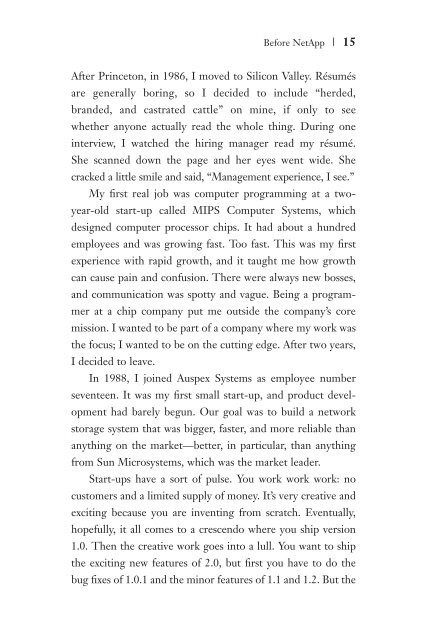Create successful ePaper yourself
Turn your PDF publications into a flip-book with our unique Google optimized e-Paper software.
Before NetApp | 15<br />
After Princeton, in 1986, I moved to Silicon Valley. Résumés<br />
are generally boring, so I decided to include “herded,<br />
branded, and castrated cattle” on mine, if only to see<br />
whether anyone actually read the whole thing. During one<br />
interview, I watched the hiring manager read my résumé.<br />
She scanned down the page and her eyes went wide. She<br />
cracked a little smile and said, “Management experience, I see.”<br />
My first real job was computer programming at a twoyear-old<br />
start-up called MIPS Computer Systems, which<br />
designed computer processor chips. It had about a hundred<br />
employees and was growing fast. Too fast. This was my first<br />
experience with rapid growth, and it taught me how growth<br />
can cause pain and confusion. There were always new bosses,<br />
and communication was spotty and vague. Being a programmer<br />
at a chip company put me outside the company’s core<br />
mission. I wanted to be part <strong>of</strong> a company where my work was<br />
the focus; I wanted to be on the cutting edge. After two years,<br />
I decided to leave.<br />
In 1988, I joined Auspex Systems as employee number<br />
seven teen. It was my first small start-up, and product development<br />
had barely begun. Our goal was to build a network<br />
storage system that was bigger, faster, and more reliable than<br />
anything on the market—better, in particular, than anything<br />
from Sun Microsystems, which was the market leader.<br />
Start-ups have a sort <strong>of</strong> pulse. You work work work: no<br />
customers and a limited supply <strong>of</strong> money. It’s very creative and<br />
exciting because you are inventing from scratch. Eventually,<br />
hopefully, it all comes to a crescendo where you ship version<br />
1.0. Then the creative work goes into a lull. You want to ship<br />
the exciting new features <strong>of</strong> 2.0, but first you have to do the<br />
bug fixes <strong>of</strong> 1.0.1 and the minor features <strong>of</strong> 1.1 and 1.2. But the


